
Natural gas prices experienced a decline of 1.27%, settling at Rs 395.3, influenced by milder short-term weather conditions that diminished immediate heating demand. The market responded to unprecedented U.S. output, as production in the Lower 48 states reached 109 bcfd in November, marking a record high. This surge has led to ample storage levels, which are currently 4.5% above the five-year average. Storage increased by 45 bcf in the week ending November 7, exceeding the anticipated 34-bcf build, although inventories are still 0.2% lower compared to the previous year. In the context of ample supply, robust demand for LNG exports persists in providing significant support.
In November, U.S. LNG feedgas demand averaged 17.8 billion cubic feet per day, an increase from 16.7 billion cubic feet per day in October, reflecting Europe’s heightened imports in response to diminished flows from Russia. Simultaneously, market participants are starting to factor in the anticipated colder weather in early December, which may rejuvenate heating demand and possibly stabilize prices.
The EIA’s latest Short-Term Energy Outlook indicates that U.S. natural gas output and consumption are expected to reach unprecedented levels in 2025. Dry gas production is projected to increase from 103.2 bcfd in 2024 to 107.1 bcfd in 2025, whereas consumption is anticipated to grow from 90.5 bcfd to 91.6 bcfd.
From a technical perspective, the market is experiencing long liquidation, as evidenced by a 1.29% decline in open interest, bringing it down to 14,677. Immediate support is established at Rs 390.1, beneath which prices could potentially test Rs 384.9. Resistance is identified at 401.4, and a breakout above this threshold may pave the way towards Rs 407.5.
